Dudu Gerstein

David (Dudu) Gerstein (Hebrew: דוד (דודו) גרשטיין) (born 1944) is an Israeli painter and sculptor. He began as a figurative painter and illustrator of children books and was recipient of the Israel Museum Prize for illustration.[1] Gerstein's post-pop art style is characterized by bold colored, multilayered cutout steel.[2] His outdoor sculpture "Momentum" is Singapore's tallest public sculpture.[3]
Biography
David (Dudu) Gerstein was born in 1944 in Jerusalem to parents who immigrated from Poland. The family moved to Ramat Gan when he was four years old. Both he and his twin brother, Jonathan (Yoni) Gerstein, showed artistic talent from an early age. David's teacher, Batya Uziel, encouraged him to study painting. At the age of thirteen he was sent to a camp for the arts in Jerusalem, which he attended for several summers in a row. In high school, he took classes at the Beit Zvi Art Center in Ramat Gan with Rina Balktovsky Arnon. During his military service in the paratroopers he was stationed at Ein Gev for one year, where he painted a series of oils of fishing docks, boats and kibbutz landscape. While there, he met the artist Aharon Giladi, who encouraged him to pursue art. Upon completion of his military service, David applied to the Bezalel Academy of Arts and Design, Jerusalem, where he met Avraham Ofek,[4] who had a marked influence on Gerstein's style.
Art career
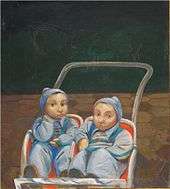
In the mid-1960s, Gerstein left Bezalel and enrolled at the École nationale supérieure des Beaux-Arts in Paris,[5] where he studied under Chaplain Midy. After two years in Paris, he moved to New York and attended classes of the Art Students League, where he learned portrait painting and printmaking.
Gerstein returned to Israel at the age of twenty six and began teaching at Bezalel. At first, he taught drawing and then became a faculty member of the Department of Jewelry Design, which was then undergoing a process of renewal under the direction of Aryeh Ophir; evolving from the outmoded, tradition style of "Bezalel" to introducing innovative concepts influenced by modern art. Due to his background in the fine arts, as opposed to jewelry design, Gerstein was responsible for closing the gap between jewelry design and the world of modern art. He exposed his students to contemporary movements, such as Danish design, expressionism, conceptual art, minimalism, and other forms.[6] He wanted jewelry design to be considered in the same light as contemporary art, no less inferior for being decorative; equal to other forms of art. Years later, Gerstein remarked that his involvement in teaching in the department influenced his transition from painting to sculpture.[6]
In 1973–1974 Gerstein earned an M.A. in graphic arts at Saint Martin's School of Art in London. Having learned lithograph and silkscreen printing in that framework, he sought to combine the two media, which had not as yet been integrated. Upon completing his studies he was awarded first prize and two awards for excellence in an end of year competition at St. Martin's.[6] Gerstein returned to Bezalel and applied some of the ideas he had formulated during his M.A. studies. He used silkscreen techniques, prevalent in modern art at the time, to the medium of enamel. Already then, his tendency to integrate different mediums and advanced technologies in creating art was discernable; a tendency that would be reflected more strongly in his use of laser in the '90s. He continued in his position as senior lecturer at Bezalel until 1985.[6]
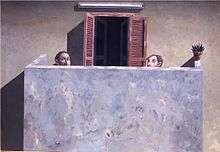
Gerstein's first exhibition in Israel was held in 1971 at the Engel Gallery in Jerusalem, comprising figurative drawings and watercolors.[7] Thereafter, he exhibited at Jerusalem's Artist's House in 1972 with large oil paintings dealing with interiors and the seaside, work that received enthusiastic reviews. Among others, Gerstein was compared to David Hockney due to the fact that "like Hockney, he, too, had been first and foremost a master drawer with an excellent color sense".[8] During those years, Gerstein led a struggle to legitimize figurative art, anomalous in the mainly conceptual Israeli art scene.[9] The conceptual art trend was irrelevant for him and he chose the less accepted orientation at the time, figurative painting. Gerstein numbered among the few artists, such as Avraham Ofek, Ivan Schwebel, Avishai Ayal, Uri Lifschitz, and others, who focused on narrative-figurative painting.
At the same period, parallel to conceptualism, an opposite trend developed: hyper-realism, inspired by Israel Hirschberg. Here, too, Gerstein did not find his place. He aspired to creating figurative paintings informed by a personal, free style; an "accessible" art. Gerstein would later explain his approach by comparing it to a literary work whose greatness lay in its different levels, so that it could be enjoyed both as a story as well as on a "deeper reading". Gerstein sought to make statements about the world and life, inter and intra-relationships and interactions with the environment, and less about statements concerning the language of art, per se. Gerstein painted memories from his past such as his mother riding a bicycle, or a childhood painting by him and his brother. Among his main inspirations was the work of Hanoch Levin who presented life's vanities in a vein of comic irony. Gerstein aspired to do the same in painting: "I tried to express in painting what Levin wrote: relationships between men and women, within families…a sort of grotesque painting".[10] Another inspiration at the time was the painter George Gross, to whom he felt an affinity and who also dealt with what Gerstein termed "the human comedy". In addition, he was influenced by David Hockney, Fernando Botero and José Luis Cuevas, who all dealt with the human experience and people' interactions.[6]
Figurative painting
In the 1970s, Gerstein explored the integration of personal statement with figurative painting, particularly in his watercolors and gouache on paper. At first, these works were intended as sketches for large canvas oil paintings. With time, though, he found interest in working in watercolors on paper, only, and they became his main medium. Gerstein created a series of paintings concerning his childhood based on photographs and memories. Another series dealt with the memory of freedom: his mother riding a bicycle in the streets of Ramat Gan, a motif that developed into a series of bicycle riders in the '90s and afterward. A repetitive motif in work describing home interiors was that of the cat and the vase, which, for the artist, expressed, "the placidity of daily routine". Both the cat and the flower vase continued to accompany his work decades later. While involved with these motifs Gerstein wanted "to escape the Israeli political reality to an Olympian turbulent-free, tranquility". In the mid-'70s, he made a series of paintings of people at the beach, influenced both by the artist's childhood memories and observation. Another series of paintings included the landscape of the Ein Kerem neighborhood, where the artist lived at the time, used as a backdrop for compositions abundant with interacting figures in groups and couples.
Sculpture
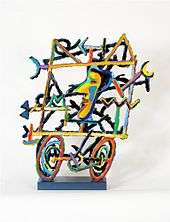
Gerstein's aim to portray the daily experience of Israeli life ironically came to fruition in the 1980s. Gerstein figuratively describes chapters from the Israeli experience, derived, among others, from childhood memories in Tel Aviv. The first series depicts Tel Aviv with its Bauhaus-style balconies, with a humoristic irony.[11] This series was based on Gerstein's memories of his parents' generation of "little Tel Aviv"; people whom he regarded with wonder and humor. These paintings express the tension between the sabra generation of the children and the relatively "exilic" generation of the parents. The series contain elderly people, the "old world" reflected in their faces, as seen from the eyes of a sabra child looking at the "generation of the desert"; the generation that founded the country, having had immigrated at a young age, yet still marked by the heritage of the "exile". The origins of this series can be found in Gerstein's watercolors and gouache on paper from the '70s, parts of which were adapted to canvas oil paintings. In the '80s, Gerstein developed this into another series of paintings, those of bathers in the Dead Sea, about which Avraham Eilat wrote,"the residents of the balconies have gone down to the Dead Sea where they lie about on the shore, covered in mud, exposing their pinkish bodies to the mercy of the sun's rays and the salt and get slowly fried".[12]
Despite the positive response his paintings evoked, both from the critics and the art world, Gerstein felt the need to renew, find new directions and expand his artistic boundaries. During 1980–1987, while continuing to paint, Gerstein experimented with wood sculptures, which were "three-dimensional while preserving a two-dimensional quality".[6] Gerstein sought to "expand the borders of painting" to the domain of the third-dimension. Dissatisfied with his few sculpting experiments, the artist discovered that he could cut and assemble the elements into a type of sculpture in space. The idea came to him during reserve duty while dismantling cardboard boxes containing cartridges. He painted on the inner partition of a box and then reassembled it. From this evolved the idea of painting on large-scale cardboard constructed into sculpture. Following a number of sculptures from cardboard, Gerstein used wood and thin aluminum. Gerstein defines those years as a "struggle" between painting and sculpture, comparing his relationship to painting as that to a wife, as opposed to his relationship to sculpture: a captivating, but forbidden, affair.[13]
Gerstein first exhibited these sculptures at the Horace Richter Gallery in 1981. This was a bold step for the thirty-six-year-old painter who had not been known for, or exhibited, sculpture previously. The works were of aluminum and wood, and the subject matter was a continuation of that of the '70s: his mother riding a bicycle, cats, flower vases and various still life elements. In the following years, Gerstein exhibited at two main galleries of the time, Sara Gilat and Ruth Debel, with work reflecting the artist's continued "search" for a new language integrating painting and three-dimensionality. In 1984 Gerstein traveled to New York, the first time since the conclusion of his studies there, and began working with the art dealer Marilyn Goldberg, who ordered the production of six limited edition aluminum prints titled "Art Cats". The series included cutouts of cats inspired by those of twelve known artists, from van Gogh to Picasso and Lichtenstein. In the wake of these works, Gerstein was invited to exhibit at the Youth Wing of the Israel Museum in Jerusalem. The exhibit in 1987 was presented under the heading, "From Dudu to 3-D", comprising sculptures that were "colorful, cheerful, amusing and reminiscent of toys or paper cutouts".[14] The exhibit was a summary of Gerstein's three-dimensional work of the previous seven years and was a breakthrough for the artist. Most of the exhibited work was purchased by museums abroad and Gerstein was subsequently invited to exhibit in the United States and Canada.
Stylistic development
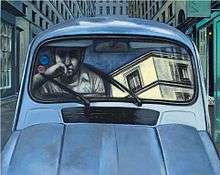
While continuing to develop his sculpture in the '90s, Gerstein returned to painting in the style that constituted a direct link to the balconies and the Dead Sea, depicted in the '70s and '80s. The series of automobiles created during this period presents people traveling in a car from the perspective of the spectator "peeping" in at the passengers through the front windshield. Similar to the motif of peeping into Tel Aviv balconies, here too, Gerstein chooses the perspective of the outsider looking at the driver through the windshield, while at the same time reflecting the surroundings. The series was created in Paris during Gerstein's residency at the Cité Internationale des Arts, 1990–1991.
In 1995, after years of woodcutting, Gerstein discovered the use of laser and began cutting metals and painting them in shiny colors taken from the car industry. He worked with Tzaki Rosenfeld, son of Eliezer Rosenfeld, owners of the mythological Rosenfeld Gallery, for seven years.
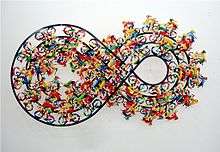
He has produced a line of work influenced by sports, such as marathon running, swimming and bicycling (exemplified by the works "Tour de France", "Yellow Shirt" and "Armstrong", after Lance Armstrong). Other motifs are urban landscapes, nature (cows, birds, and flower vases) and human behavior ("Heads", Jazz Players). His workshop and gallery are located in Jerusalem's Talpiot industrial zone. He is the owner of two galleries, in Tel Aviv and Jerusalem.
Outdoor Sculptures
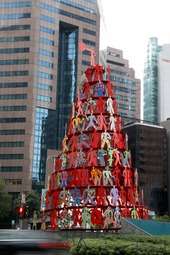
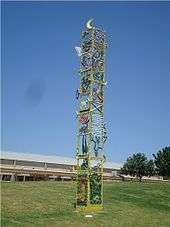
Gerstein is known for his outdoor sculpture, many of them decorating city squares. His sculptures can be found at the entrance to the Rehovot Mall, Ra'anana Park, Avdat and on the campus of the Hebrew University of Jerusalem. His sculpture of a Roman warrior is in Bromford, London. His sculpture in the Singapore business district is 18.5 meters high.
Artistic concepts

From the 1970s, Gerstein aspired to create art that would speak to the art world while remaining accessible to the man in the street. His bold use of color came from a desire to "copy nature." Gerstein explained that just like the brightly colored fruit or flower in nature attracts insects, so, too, his work was intended to be attractive to the observer. And as the fruit is not solely an object of attraction, but is also a source of vitamins, so, too, his works contain added value. "I expressly deal with images of consumerism and the lure of the color is strategic". His work "Shoe Mania", portraying a woman whose hair is composed of shoes is colorful but expresses criticism of Western consumerism. Gerstein maintains that "not everything needs to be heavy" in art, and that "there can be art for pleasure's sake", in which its deeper message, if there be, is hidden.
Another guiding principle in Gerstein's work is leaving the boundaries of the gallery. In 2002, he began working on unnumbered editions of small-scale, silkscreen sculptures for sale in museum stores at modest prices. According to the artist, "High art and low art go together and I want to break the unnatural divide between the museum and the street."
Criticism
Gerstein's use of vibrant, bright colors has been called "decorative" and "commercial." Gerstein says: "The forms and colors in my work are my way of communicating. Those who taste the fruit will discover that it is not only beautiful, but also replete with vitamins. My work "The Human Circle" resembles a huge flower or bouquet, but beneath the surface is a tacit criticism of human life; the insight that we come from nowhere, are going nowhere, and in the meantime, are going around in circles, chasing our tails. Whoever chooses to see the work as a decorative bouquet, is welcome. But if you look at the characters comprising the "Human Circle", you will see that they are not pretty. In fact, they are even ugly. But the overall picture is beautiful and seductive".[15]
On his use of serial, as opposed to individual works, Gerstein replies, "Warhol made silkscreens". It does not really matter if an artist paints a work with his own hands, or if they are painted by assistants or printed. Gerstein believes that "everyone deserves art, even art on the level of a silkscreen that's bought the way one would buy a quality wine". There are different levels. I don't choose to brand myself as an artist for only the top decile, but for all. It's only right that everyone gets to enjoy art".[15]
Selected solo exhibitions
- 1971 Engel Gallery, Jerusalem.
- 1972 The Artists' House, Jerusalem.
- 1980 Horace Richter Gallery, Tel Aviv.
- 1982 Horace Richter Gallery, Tel Aviv.
- 1984 Radius Gallery, Tel Aviv (a member of Radius Group).
- 1987 Israel Museum, Jerusalem ("From Dudu to 3-D") Albert White Gallery, Toronto.
- 1988 Haifa Museum of Contemporary Art ("Frames").
- 1989 Herzliya Museum ("Totems") - Albert White Gallery, Toronto - "Art 20" International Art Fair, Basel.
- 1992 Yavneh Art Workshop ("Pupils") - "Art Frankfurt" International Art Fair.
- 1993 Ashdod Museum ("Extended Pupils").
- 1994 Rosenfeld Gallery, Tel Aviv ("Cutouts").
- 1995 "Art Multiple", Düsseldorf Conzen Gallery, Düsseldorf.
- 1996 Center of Performing Arts, Tel Aviv - Moria Gallery, Washington D.C. - "Art Multiple", Düsseldorf - Zimmermann und Heitmann Gallery, Dortmund - Breitbach Gallery, Unna (organized by Gallery Ostendorff, Münster, Germany).
- 1997 "Encircled People", Rosenfeld Gallery, Tel Aviv - Conzen Gallery, Düsseldorf - Galerie IM Kornbrennerei Museum, Telgte - Edition of Art, Innsbruck Gallery 33, Essen - Gallery Ostendorff, Műnster Germany.
- 1998 Gallery Regenbogen, Stuttgart - Gallery Menzel, Bad Honef - Gallery Auf der Treppe, Limburg - Gallery Konig, Darmstadt.
- 1999 Ambassador Gallery, Palm Beach, FL - Gallery Silecchia, Sarasota, FL - Newbury Fine Art Gallery, Boston - Stricoff Gallery, New York - Aduko France Fine Art, Lyon - Art Symbol, Paris - Art Seiler, St Paul de Vence - Gallery Plakart, Frankfurt - Gallery Veith, Ludwigsburg - Gallery Hohmann, Koln - Gallery Krombholz, Koln.
- 2000 Gallery 33, Essen - Gallery Fischerplatz, Ulm – Galerie de Cannes, Cannes - Art Symbol, Paris - Danielle Peleg, West Bloomfield - MI Gallery "PZ", Krefeld.
- 2001 New River Gallery, Ft. Lauderdale, FL - Galleria Silecchia, Sarasota, New York - Newbury Fine Art, Boston - Barrington Gallery of London, New York.
- 2001 "Tango Sur Seine", paintings, Artists House, Jerusalem.
- 2001 "Pixul", Art Gallery at The Memorial Center, Kiriat Tivon.
- 2001 "The Private Sector", Meirov Municipal Art Gallery, Holon.
- 2002 "Balance Trial", The Municipal Gallery "On the Cliff", Netania.
- 2002 Osklen Multimedia Space, Ipanema, Rio de Janeiro, Brazil.
- 2002 Peter's Gallery, Nicosia, Cyprus.
- 2002 Mensing Gallery, Hamm, Germany.
- 2002 "No Favorite Color", Street Installation during Documenta, Kassel, Germany.
- 2003 Nord L/B Gallery, Hannover, Germany.
- 2003 Nouances et Lumiere Gallery, Lyon, France.
- 2003 Clube A Hebrica, Sao-Paulo, Brazil
- 2003 Galery Genner-Duisburg, Germany
- 2003 "Typical Section" Art Center at Ma'a lot, Israel
- 2003 Art Symbol Galery, Paris, France
- 2004 Galerie Am-Dom, Wetzlar, Germany
- 2004 Star Gallery, East Sussex, England
- 2004 Ostendorff, Munster, Germany
- 2004 "In constant movement" Municipal Gallery, Ness-Tsiona, Israel
- 2004 Galeria Kreisler, Madrid, Spain
- 2004 Gstaad Adler, Geneva, Switzerland
- 2005 Mensing Galleries in Hamburg, Berlin, Hanover, Germany
- 2005 Coda Gallery, Palm Desert, CA, USA
- 2005 Galerie Nuance et Lumiere, Lyon, France
- 2006 Due-Diligence, Stadtische Galerie im Park, Viersen, Germany
- 2007 Gana art gallery, Seoul, Korea
- 2007 Gallery Ermanno Tedeshi, Milan, Italy
- 2007 Catto gallery, England
- 2007 Mensing Galleries in Düsseldorf, Munich & Hamburg, Germany
- 2007 Rollebeek Gallery 28, Brussels, Belgium
- 2008 Ermanno Tedeshi Gallery - Milan, Italy
- 2008 Gana art gallery, Seoul, Korea
- 2008 Mensing Galleries in Düsseldorf, Frankfurt & Hamburg, Germany
- 2008 Ermanno Tedeshi Gallery, Rome, Italy
- 2008 Mairie de Hesperange - Luxembourg
- 2008 Rollebee Gallery 28, Brussels, Belgium
- 2008 Gana Gallerry, Busan - Korea
- 2008 Cultural Center, Modiin, Israel
- 2008 Momentum Art Gallery, Knokke, Belgium (www.momentumartgallery.com) - Official Permanent Gallery
- 2009 Momentum Art Gallery, Knokke, Belgium (www.momentumartgallery.com) - Official Permanent Gallery
- 2010 20.3. - 17.4. "Celebrating forms and colors" Gallery Ostendorff, Münster Germany
- 2010 Momentum Art Gallery, Knokke, Belgium (www.momentumartgallery.com) - Official Permanent Gallery
- 2010 Horizon Arts Gallery, Miami, FL Official Gerstein Gallery In USA - www.davidgerstein.us
- 2011 Momentum Art Gallery, Knokke, Belgium (www.momentumartgallery.com) - Official Permanent Gallery
- 2011 Horizon Arts Gallery, Miami, FL Official Gerstein Gallery In USA - www.davidgerstein.us
- 2012 Momentum Art Gallery, Knokke, Belgium (www.momentumartgallery.com) - Official Permanent Gallery
- 2012 Horizon Arts Gallery, Miami, FL Official Gerstein Gallery In USA - www.davidgerstein.us
- 2013 Horizon Arts Gallery, Miami, FL Official Gerstein Gallery In USA - www.davidgerstein.us[16]
- 2014 Ostendorff Gallery, Münster, Germany (Solo exhibition, opening, 19.9.2014)
Selected group exhibitions
- 1972 The Print Biennale, Florence.
- 1973 "Israeli Graphic Art Today", Tel Aviv Museum.
- 1981 "Four Artists", Sara Gilat Gallery, Jerusalem.
- 1983 "New Acquisitions", Israel Museum, Jerusalem - The Triennale of Israeli Graphic Art, Haifa Museum - "New Prints", Jerusalem Print Shop.
- 1985 "Four Sculptors", Aika Braun Gallery, Jerusalem - "Towards a Godless Myth", Artists' House, Jerusalem.
- 1986 "There are no Bad Animals", travelling exhibition, Omanut La'am - "Artists on Miluim (Army Reserves)", Debel Gallery, Ein Kerem.
- 1987 "Flags", Israel Festival, Jerusalem - "Towards a New Israeli Realism", Uri and Rami Nechushtan Museum, Kibbutz Ashdot Ya'akov - "Four Artists", Meimad Gallery, Tel Aviv - "Quotation-Painting-Quotation", Museum of Israeli Art, Ramat Gan - "Six Israeli Artists", Billboard Sculptures, Israel 40th Anniversary, Fairs Center, Tel Aviv.
- 1988 "Haifa, Portrait of a City", Haifa Museum of Contemporary Art - International Biennale of Graphic Art, Ljubliana.
- 1989 "Via Maris", Bat Yam Museum - "These Sabras", Municipal Gallery, Jerusalem - "Artists' Studios", Aika Brown Gallery, Jerusalem.
- 1990 "Health and Long Life", Humor in Israeli art, Omanut La'am, travelling exhibition - "Leaves", Artists' House, Jerusalem.
- 1991 "Who's Afraid of Kitsch?", Yad Labanim Museum, Ra'anana.
- 1992 "Homage to the Cit?", Artists House, Jerusalem "Flowers", Omanut La'am, travelling exhibition "Receptacle and Contents", Artists' House, Jerusalem.
- 1993 "Persistent Image", Haifa Museum of Contemporary Art, Bat Yam Museum - "Childhood Reminiscence", Memorial Center in Kiryat Tivon - "Tel Aviv in the Tracks of the Bauhaus", the old building of the "Ha'aretz" newspaper, Tel Aviv.
- 1994 "Israeli Sculpture, The Last Decade", Tefen Museum.
- 1995 "Object-Object: Dialogue between Art and Design", Municipal Gallery, Kfar Sava - Ashdod Museum.
- 1996 "Local Line" Neve Tsedek Gallery, Tel Aviv - "Art Multiples 96'", Düsseldorf.
- 1997 "Box", Israel Museum, Youth Wing, Jerusalem - "When the Dinosaur Met the Bird", Bat Yam Museum - "Samson and Delilah", Ashdod Museum.
- 1998 "Look at the Vase", Arad Museum Land Marksn - Open Museum, Teffen.
- 1999 "End 2000", Haifa.
- 2000 "Public Art", Givataim – "The Year of Brand ', The Villa, Jaffa – "I Have a Dream", The Holon Interdisciplinary Center for Art and Science.
- 2001 "Childhood", Waddi Nisnass, Haifa.
- 2001 "Balances", The Tel Aviv District Court.
- 2001 "Work in the Eyes", Ha'Shfela Museum, Kfar Menahem.
- 2001 "B'Tselem", Ten Years to the Organization, Givatayim Theatre.
- 2002 "The Dolphins Project", Tel Aviv.
- 2002 "The Lyons Project", Jerusalem.
- 2002 "An Homage To Yoseph Hirsh" Tel Aviv's Artist's House.
- 2002 "Markers", The Electricity Company in Kassel, Germany.
- 2002 "Markers", Jerusalem Theatre and Yaalom Theatre.
- 2002 "Sculpture as Toy", Bat Yam, Arad, Ashdod, Rechovot, Kfar Saba Museums.
- 2002 "Art on the Line", for the Haifa Museum of Art Friends.
- 2002 "W.C. Environment", The Stage Arts Center, The Opera House, Tel Aviv.
Selected art in public spaces
- 1985 "Bicycle Rider", Hebrew University, Mount Scopus, Jerusalem.
- 1988 Sculptural children's playground, Weiller Park, Jerusalem.
- 1989 "The White Rider", City of Lod.
- 1992 "Kiosk", Israel Museum, Jerusalem - Six sculptures at Avdat archeological site, the Negev.
- 1993 "Great Tree", billboard project in Ramat Hasharon - Wall relief, main office of the Electric Company, Jerusalem.
- 1994 "Ladder of Motives", Open Museum, Tefen.
- 1995 Two wall pieces for Bank Leumi, Tel Aviv - "The Flower Vase", Bank Leumi, Rehovot - "Jacob's Ladder", Israel Festival, Jerusalem.
- 1995 Tree of Donors, The Science Museum, Jerusalem.
- 1996 "Scientific Orange", Rehovot shopping & central bus station Mall Israel Festival, Jerusalem "Head Within a Head", the Hebrew University, Jerusalem - "Island of Flowers", Brigada Street, Herzliya.
- 1997 "Above the Head", Installation, Hebrew University Givat Ram, Jerusalem - "City Square", Center of Performing Arts, Tel Aviv "Pupils", Dizengoff Street, Tel Aviv.
- 1998 "Cow", Raanana Park, Raanana, "Cats Hill", Neve Amal, Herzliya.
- 1999 "A Whole World", Hebrew University, Jerusalem – "The Bus", Hebrew University, Jerusalem - Homage to Alterman, Dizingoff Street, Tel Aviv.
- 2000 "Audience", Jerusalem Theater, Jerusalem.
- 2001 "Day and Night", Bezeq Lobby, Azrieli Center, Tel Aviv.
- 2001 "Colors from Nature", Horev Center, Haifa.
- 2001 "Things that come from the Heart" (sculptures), Ramat Alon Park, Haifa.
- 2002 "Soul Bird", Holon.
- 2002 "Digital Zabar", Waddi Nisnass, Haifa.
- 2002 "No Favorite Color", 3 months Installation, Kassel, Germany.
- 2002 "Shalom On Israel", Rabin Building, Judaism Center, Hebrew University, Jerusalem.
- 2003 "Blue Mermaid", Kiryat Yam, Haifa.
- 2003 "Rush Hour", Hebrew University, Jerusalem, Israel
- 2005 "Sun Rise" High School, Ashkelon, Israel
- 2005 "Butterflies", Harel, High School, Mevaseret, Israel
- 2007 "Ohel Moed", Sculpture Park, kibbutz Hatzerim, negev, Israel
- 2008 "Momentum" CBD, Singapore
- 2008 "Star City", Seoul, Korea
- 2008 "Field of Butterflies" Loby of "Beit Reich", Tel AViv, Israel
- 2008 6 sculptures ("Sport Island"), Netanya, Israel
Other projects
- 1978–84 Illustrations for children's books.
- 1991 Design of "Winged Paint-Tube", gift of the Israel Museum to its donors on the occasion of its 25th anniversary Designed object-sculpture for the exhibition.
- 1993 "To Live in Jerusalem", Israel Museum, Jerusalem Curator of "Artist Fosters Artist" exhibition, Artists' House, Jerusalem.
- 1994 Performance with Anat Shamgar (dance) and Jean Claude Jones (cello), Habama Theater - One-year calendar for Flying Cargo (Fed-Ex) Company Illustrations for Ha'aretz and Kol Ha'ir newspapers.
- 1996 Billboards for "American Express".
- 1997 Series of Brooches.
- 2002 Objects created for "Doolittle Articles" Company.
- 2002 Renew of Brooches by "2Doo" Company.
- 2004 Sculptures to the "Rabin Medical Center", Israel
- 2004 Collection of paper products with Gerstein Design by Dornat
- 2004 "Journey into the Body" Rabin Medical Center, Petah Tikva, Israel
- 2005 Book jackets for Ruvik Rosenthal "Comprehensive Dictionary of Hebrew Idioms", and for Orly Castel-Bloom "No arguments with rice".
- 2006 Objects created for "Eden Fine Art Gallery"
- 2007 Greeting cards - The Israeli post
- 2007 One-Year calendar for Palphot company, Israel
- 2008 One-Year calendar for Kolon company, Korea
- 2008 One-Year calendar for Palphot company, Israel
- 2008 David Gerstein/Sculptures - Book
- 2013 David Gerstein "Past and Present" - Book / published by the artist and Skira ISBN 978-88-572-1064-3
See also
References
- ↑ In 1980 Gerstein was awarded the Ben-Yitzhak Israel Museum Prize for illustrations for book by Uri Orlev, Siamina and the Cats of Yemin Moshe, Am Oved Publishers, Tel Aviv 1979. See: The Big Book of Illustrators, Nurit-Shilo Cohen, ed., Israel Museum, pub., 2005.
- ↑ Irena Gordon, Introduction to David Gerstein, Sculptures, Studio Gerstein pub., 2006
- ↑ Wong Mun Wai, Singapore's tallest public sculpture in the CBD is completed, Channel NewsAsia, at: http://www.channelnewsasia.com/stories/singaporelocalnews/view/320058/1/.html, retrieved: 09.10.2011
- ↑ Naomi Aviv, David Gerstein Sculptures, Catalogue, Rosenfeld Gallery, pub., 1997
- ↑ Yona Fisher, Balconies, Domino Pub., 1984, p.3
- 1 2 3 4 5 6 Naomi Aviv, David Gerstein Sculptures, Catalogue, Rosenfeld Gallery, pub., 1997
- ↑ Amnon Barzel, Ha'aretz, Feb. 19, 1971
- ↑ Meir Ronen, The Jerusalem Post, March 13, 1978
- ↑ See for example: David Gerstein, Long Live Pluralism", Yediot Achronot, March 2, 1978
- ↑ David Gerstein, Balconies, Domino Pub., 1984
- ↑ Avraham Eilat, Sea, Mud and Salt, National Maritime Museum, Haifa, pub., 2010
- ↑ Irena Gordon, Boundless Painting, David Gerstein Sculptures, Gerstein Pub., 2008
- ↑ Ruti Rubin, "From Eli Ohana To Marcel Duchamp", Hadashot, March 24, 1987
- ↑ Dana Gilerman, "True to the Original", Ha'aretz, Nov. 14, 2008
- 1 2 "דוד גרשטיין נעלב כשקוראים לו מסחרי". 19 May 2008.
- ↑ Horizon, Arts. "David Gerstein Gallery". http://www.davidgerstein.us/david-gerstein-art-work/. External link in
|website=(help)
External links
| Wikimedia Commons has media related to David Gerstein. |
- Official website
- GersteinART
- David Gerstein in Germany
- David Gerstein in Miami, FL USA
- Gerstein in South Africa